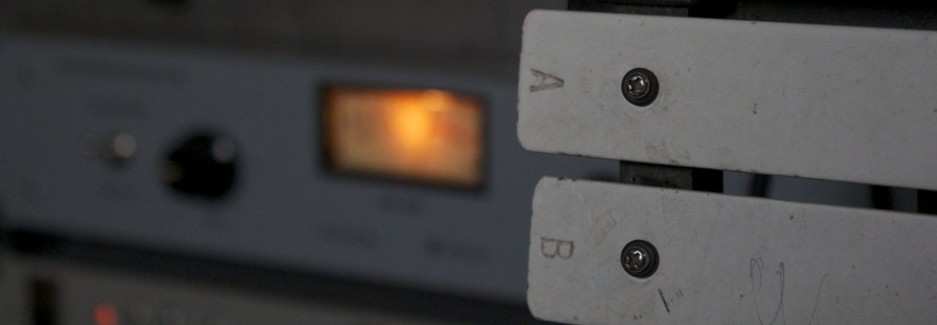In the previous post it was briefly suggested that in a multi-microphone arrangement, the relative position of microphones determines which frequencies are being picked up in phase and which are being picked up out of phase.
From that post we learned about the congenital phase displacement of condenser microphones as opposed to moving coils rather than ribbons. We also re-categorized moving coils and ribbons as electromagnetic microphones.
Now let’s analyze the simpler case, when in the capture are involved microphones sharing the same type of transduction: be they both condensers or both electromagnetics.
The basic arrangement is to place them coincidents, as close as possible to the source: a situation when you just want a different, alternative sound: virtually no phase difference occurs and both capsules pick up sound pressure’s variations at the same time.
But say you are spacing microphones 1 meter apart in the direction of the source, one closer and the other one placed farther away.
There is one (and only one!) frequency which cycles with a wavelength of 1 meter: that’s 340 Hz. As the complex sound wave propagates from the source towards the first and then the second microphone, capsules will pick up 340 Hz with no difference in phase since they are placed at the distance corresponding to one exact cycle of 340 Hz from each other.
The positive combination of energy will reinforce that frequency.
The same arrangement though will suffer major phase issues at the frequency one octave lower, the one for which the distance of 1 meter corresponds to half wavelength.
This is what goes on: exactly when that frequency is picked up by one of the two microphones, at the other microphone the phase of that same frequency is 180° inverse.
Full out of phase combination, i.e. cancellation of the frequency: that’s 170 Hz (340/170 = 2 meters wavelength).
To further expand: let’s call D the distance between microphones. D is half the wavelength of the canceled frequency one octave lower (170 Hz). D is also 3/2 wavelength of the closest higher, canceled frequency (510 Hz) and D is also twice the wavelength of the higher octave (680 Hz), perfectly in phase and therefore boosted. And so on: D is 5/2 wavelength of 850 Hz (canceled) and is 3 times (6/2) the wavelength of 1020 Hz (boosted). 7/2 of 1190 Hz (canceled), 4 times (8/2) 1360 Hz. In fact such an arrangement works like a comb filter: draw the frequencies boost/cut pattern on a piece of a paper and you’ll immediately understand where such a name comes from.
If you change the distance between microphones (of the same type), different frequencies will be canceled and boosted. The filter’s curve shifts to a lower region of the audio spectrum if distance is increased, to a higher region if distance is reduced.
One very interesting consideration: we’ve seen that distance D corresponds to half wavelength of the canceled, lowest filtered frequency. Sure enough you can invert polatity of one of the two microphones and by doing so you reverse the shape of the filter, i.e. boost that lower octave without changing D. In the previous case 170 Hz would be boosted, 340 canceled and so on.
Pay attention: this also means that given a target frequency, you can place microphones at half D (i.e. half wavelength) from each other and still get perfect alignment at that frequency by inverting the polarity of one of the two mics. Let’s better study the case with an example. Say you are looking for a solid in-phase alignment at 80Hz. That’s a 4,25 meters wavelength. That’s your D, distance between microphones. With microphones spaced like that, you’d get 0° correct phase at 80Hz, 160 Hz, 240 Hz, 320 Hz (note: all the harmonics!). You’d also get 180° inverted phase at 40 Hz, 120 Hz, 200 Hz, 280 Hz. Consider this: if by pushing the polarity button you reverse the filter and get 0° correct phase at the lower octave, you can
1) place microphones at half D (wavelength of the higher octave) and obtain 160 Hz in perfect phase, 80 Hz 180° out-of-phase…
2) push the button… et voilà: 0° phase at 80Hz (lower octave) and 180° at 160 Hz.
All this brings us to one very important, second notion which in fact should be regarded as supreme law: there is no such thing as a generic phase issue pertaining to the combination of two (or more) microphones. Phase issues are frequency dependent: given a certain distance between microphones, some frequencies will suffer, some will actually benefit!
Someone might tell you that pushing the polarity button of your preamp helps you solving the problem… Which problem? The phase problem? Mmmhhh… not that easy! Phase is frequency dependent: what the button does is shifting the whole in-phase/out-of-phase pattern (the filter curve) an octave lower in this specific case of microphones of the same type (we’ll analyze in the next post the case with microphones of different type).
The problem isn’t being solved, it’s just being moved to a lower region of the audio spectrum, which can be very desirable at times. Note that below 2D, none of the frequencies oscillates so that inverting their polarity will give 180 degree inversion: their wavelength is just too long.
Conclusion: microphones with the same type of transduction can be positioned in phase to a specific frequency according to the pattern:
– coincident
— half D, one mic output w/ polarity inverted
— full D, both mic outputs with the same polarity
Try yourself!





